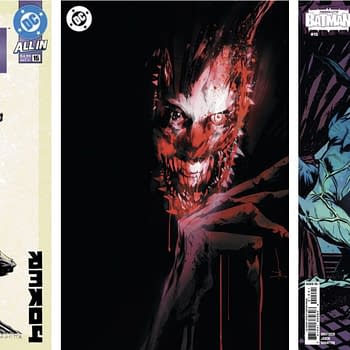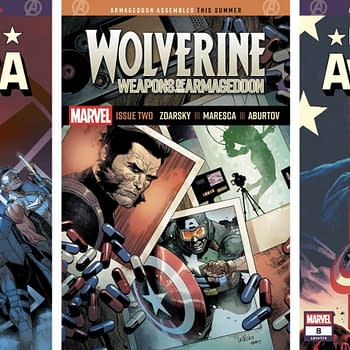Posted in: Comics, Recent Updates | Tagged: ales kot, Comics, entertainment, image comics, Tom Muller, zero, Zero Volume 1: An Emergency
Ales Kot Talks About Zero Volume 1 And Writing The TV Pilot – Look! It Moves! By Adi Tantimedh
Adi Tantimedh writes:

Ales Kot is a writer who wears his intellect, his influences and his heart on his sleeve. Last week, the first five issues were collected into a trade as Zero Volume 1: An Emergency, and it was time to chat with him about it, with designer and collaborator Tom Muller chiming in on the visual design of the series.
Adi Tantimedh: So we've come to the end of the first five issues and the first trade collection, we start to see the shape of a long-term arc and the persistent themes that will play out over the series. It also feels like this is the first act. Has everything turned out the way you planned?
Ales Kot: Yes and no. I intended to create a comic book unlike anything else out there and the entire team succeeded at that. I also had a large amount of notes and a few different outlines for the story. In certain moments I chose to adjust direction as I was writing the scripts. This felt perfectly fine because the hard work on the outlines allowed me to move things around. Some story beats were dropped, some added, some shuffled around. Has everything turned out the way it was in the last outline? No. And is the story better for it? Yes. And that's what matters to me.

AK: Well, that's the thing — is Zero just that? Is he a victim and a monster and a tragic figure, and is that where the story and the person end? I have a fondness for narratives that don't reduce protagonists to soundbites, and that means I am also not likely to make a story that would go in an oversimplified direction. I can safely say that there's much more to Edward Zero, and this will be explored as we go deeper into the story. The core of Zero is pulp — pure and simple. What happens next is the characters, alive with their hearts beating and pumping, take the pulp narrative and deform it.
AT: Each issue on its own was very meticulously designed, with the cover and text sections as integral to the story as the comic pages were. Can you talk about the design ideas and philosophy you and Tom Muller used behind each issue?
AK: Thank you. The basic philosophy is hire the right people, explain your vision in detail and then let them do what they do best. As the team does the work and the communication is open and honest, the creative vision becomes a shared creative vision of the entire team. My position on Zero is essentially that of a writer and a showrunner.
Tom, take it away.
Tom Muller: When we started talking about Zero early last year, our original vision was to eschew artwork, and create covers that are purely image and typography led and in the process create something that truly stands out on the shelves. With the first issue set in the Gaza Strip, I researched satellite and drone cam footage of the area and used that the visual language to create that first cover — however, when we started to review things, we opted to incorporate artwork, primarily because we didn't want to pull the book so far away that a potential audience would be alienated by it (we're after all making a commercial product). So we developed a system where each artist (including guest cover artists) gives me a black and white illustration that I then integrate in the cover design; rather the opposite of what you'd call the traditional cover design route where whoever designs or artworks the cover only has space to drop in a logo each and every issue.
I felt strongly that each issue should be designed from the ground up, to accurately reflect the individuality of each issue. Even though the use of typefaces and the basic logo are consistent, they are treated and manipulated differently so the difference in each becomes the element that holds everything together. The other, important element is that I want to create an end-to-end design experience: from the moment you look at the cover, read the story and close the comic, the design runs through it and forms a part of the story, never taking you out of the book — I think that this really reinforces the story and reading experience.
AK: As Tom said, this developed even further when we realized the entire issue should be about Zero, from start to finish. No ads. Just the experience. Developing the extra text and design sections stemmed from that and also from a sense that in order to be true to the story, more layers of it should be explored. I believe that the first time I discovered this technique in comics — the added reports, newspaper clippings, books within books and such — was in Watchmen, although this sort of an approach runs through fiction for much longer than that. Umberto Eco, Nabokov, Orwell, Borges and so on. F is for Fake by Orson Welles.
This approach goes back to the story itself. The story and the approach define each other. Zero is about a man undergoing profound changes — and the morphing design reinforces the main theme as well as the layers emerging from it.

AK: You said it right: that's what it looks like. It might be something else entirely. I know what happens throughout the story, and I know what the last scene is, at least in part, however I am also purposefully leaving it vague. As I write the story and things morph, new possibilities open up. This is similar to the process Vince Gilligan and his team employed when writing Breaking Bad. They intended to kill Jesse Pinkman and then realized they had a blessing in such a talented actor and such a well-written, multi-dimensional character. So they changed their plans.
AT: How far do you like new ideas from the news influence the plots for the series and the eventual ending?
AK: There's no right and wrong on this. It's a matter of letting the right ideas come to me. It can be anything — a hacking scandal, a declassified CIA report, a particularly interesting color of the sky. The only thing that matters is whether it connects with the story, and I don't find that there is a way to completely rationalize the process of choosing what goes in and what does not.
I am aware of plot dynamics and character arcs. I am aware of various storytelling schools. I am also aware of the fact that human experience can not be entirely encompassed by logic, or that it at least refuses to do so in my case. There has to be room for chaos in the creative process because imagination thrives on chaos. I find that when I blend my approach to order — the awareness of the classical, the pulp roots, the storytelling schools — with my approach to chaos, my best storytelling comes out of it.
AT: I detect the whole story really comes down to the tragedy of this man who's been brutalized and molded into a weapon by various political forces fighting each other for profit and leverage. There's a sense of horror over the fact that people just can't get along to the point where they have to turn other people into monsters and tools to do their dirty work for them. Or am I reading too much into it?
AK: You get it. I don't believe a story can be just one thing — we humans are storytelling machines and we always find new ways of telling and understanding stories. We find plenty different angles on one story. This is one of the key ones and definitely one I directly identify with. I grew up reading horror. The books of Stephen King and Clive Barker (and one particular story by Ramsey Campbell, 'The Faces at Pine Dunes', which I read at a summer camp) influenced me before I turned ten or eleven. Inevitably, this influence can be traced in every single one of the comics I have created at Image — Wild Children, Change and Zero all contain cosmic dread as one of their essential ingredients. It delighted me when a reader brought up that from one angle, Wild Children is a horror story. Of course it is. That's the beauty of well-crafted fiction — it can be many things to many people while maintaining its essence, and what you described is a big part of the essence of Zero.
AT: It's no secret you have interest from producers and are now writing a pilot script version of Zero. Will it be a straight translation of the first issue or a new story?
AK: Definitely a new story. Although there are a few similarities, I believe that an adaptation for another medium has to be its own thing, a creation that is made with that specific medium in mind. So that's the rule I'm following, as I have no interest in writing the same thing twice.
AT: What are you finding to be the biggest differences in writing a screenplay and comic script so far?
AK: I trained (and continue to train) extensively in both disciplines — and more — ever since I decided to be a writer. This means I come prepared. The main difference in regards to this specific project is this: the screenplay demands simplicity. And I delight in building a simple sentence. I love cutting words out. So it comes naturally.
My approach to writing comics scripts for Zero oscillates between that simplicity and a more baroque approach, depending on the specifics of the story and the artist I am working with. At the end of the day, it's about what a screenplay and comic script have in common: absolute clarity in telling precisely the story I want to tell.
AT: So how did you determine the setting and plot of the pilot script? Did you have to consider the lower budgets TV shows have as opposed to movie budgets?
AK: Let's put it this way: I am an idealist and a realist at the same time. The format of the show, the setting, all of this is considered from many different angles, economics included. I am completely happy with what I came up with.
AT: So what's the basic format of the show? Are you thinking about a season-long story arc?
AK: I know what it is, but at this point I choose to stay quiet on the subject.
AT: Television can be very demanding with its main characters, especially anti-heroes. What is it about Edward Zero that you think might make him compelling, if not necessarily sympathetic, as a protagonist to an audience?
AK: Well, that's pretty simple. Zero is the James Bond for this century.
Ales Kot can be found at www.aleskot.net. Counting down to zero at lookitmoves@gmail.com
Follow the official LOOK! IT MOVES! twitter feed at http://twitter.com/lookitmoves for thoughts and snark on media and pop culture, stuff for future columns and stuff I may never spend a whole column writing about.
Look! It Moves! © Adisakdi Tantimedh



















